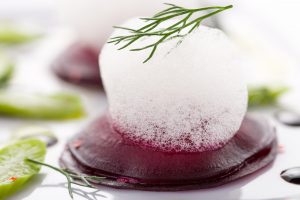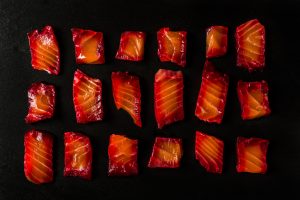Mastering texture in the kitchen is what separates good chefs from those that are great. While flavours need to weave together in an intricate dance, texture is where we deliver surprise to customers and deliver a pleasurable mouthfeel that, when done well, exceeds expectation. And that’s where the secret lies, exceeding expectation. If every mouthful tasted and felt exactly as we expected, there would be no excitement, nor marvel, no wonder. By its very nature, food service operating at the higher end of the spectrum is built on the very foundations of impressing diners. Our job is to give a meal that could not be created at home and therefore, one of the most powerful tools we have in the kitchen is the ability to control and manipulate texture.
Many modernist techniques such as spherification and dehydration are successful because they transform the normal texture of a food. At El Bulli, it was a shock for diners to taste the pure, clean flavour of a green olive, but with an exploding yolk-like liquid. Our association between flavour and texture is broken and in the confusion, diners find delight. Or so the theory goes…

None of this is new information to you I’m sure, but what’s most interesting at this time, is how the dining public have become more interested in texture. Thanks to the media attention garnered by the likes of Rene Redzepi, Ferran Adria and Heston Blumenthal, the surprise of obscure texture is now an exciting talking point, something to look forward to.
Of course, prizing texture so highly can be seen as a relatively new fascination in the UK and wider western world. In Asia, particularly in Japan and Korea, texture has long been a strong focus in food preparation. It’s in these countries that you’ll find the somewhat rare appreciation of textures like cartilage and tendon. A gelatinous mouthfeel is another texture that’s highly cherished in these far eastern countries and while we may be used to it in sweet desserts and puddings, in these cultures it is also lauded in the savoury realm.
These gelatinous textures are often found in unsung leftovers from animal butchery, or preparing certain ingredients in a raw form. Slowly but surely, these difficult textures are gaining traction on menus closer to home. Partnered with familiar, but interesting flavours, the surprise of this texture can work and we are seeing ingredients like jellyfish beginning to get some attention not only for its unique gelatinous-yet-crunchy texture, but thanks to it being a highly sustainable food source endorsed by the United Nations.
While you’re likely to be experimenting with food textures already, this realm is most certainly an area to push forward in. Whether you’re looking to deliver satisfying signs of freshness, or putting playful twists on common ingredients, balancing contrasting or complementary textures is rapidly becoming an art form in today’s progressive kitchens.


